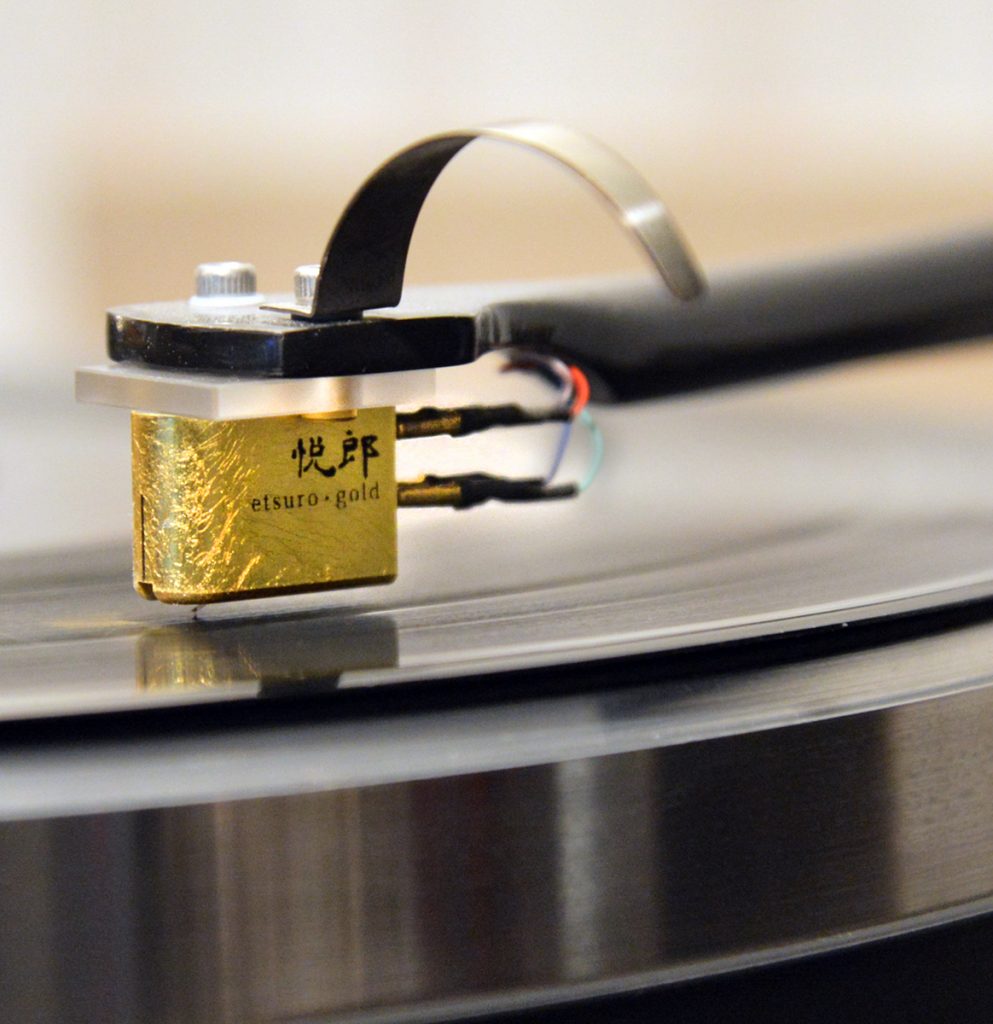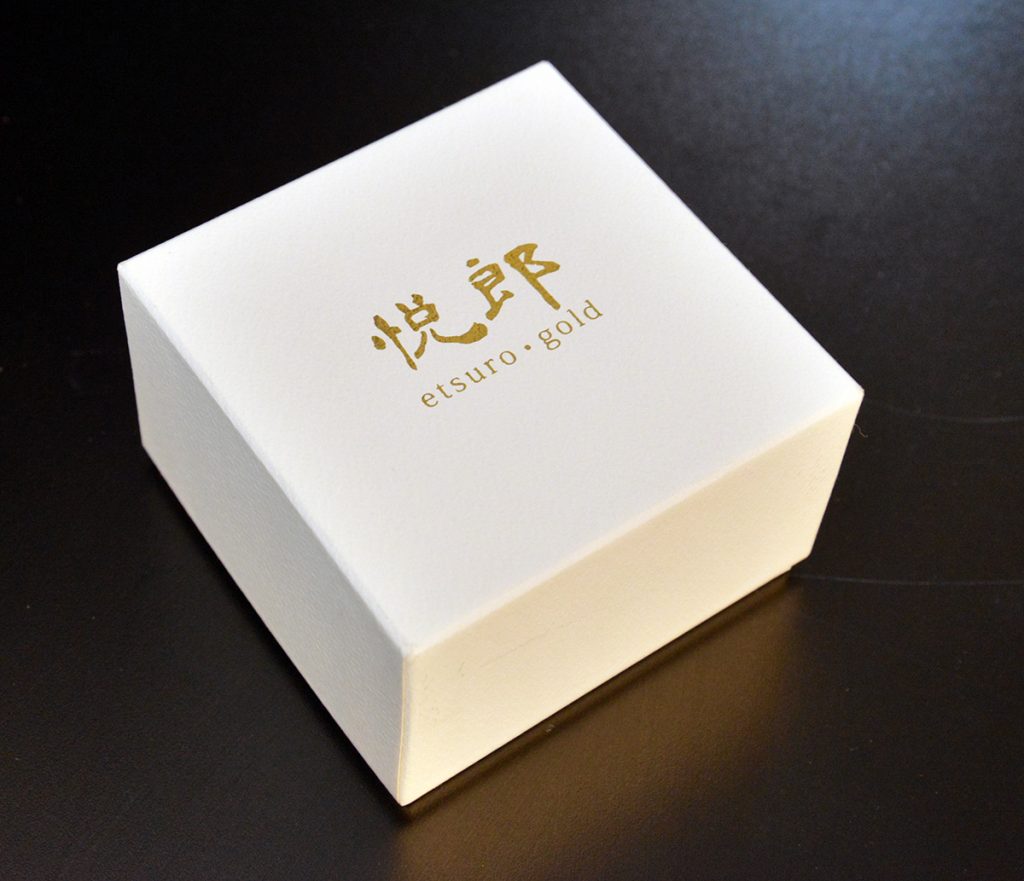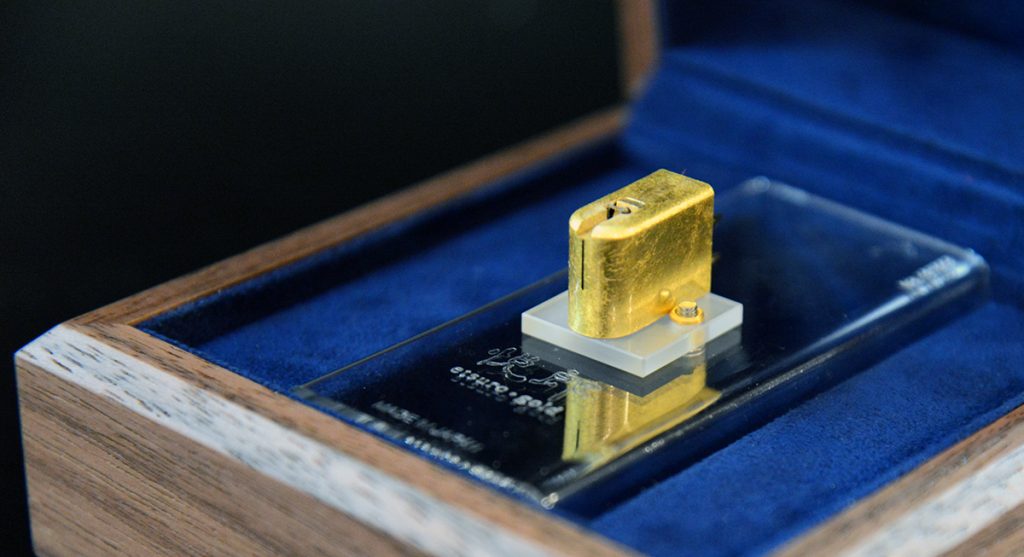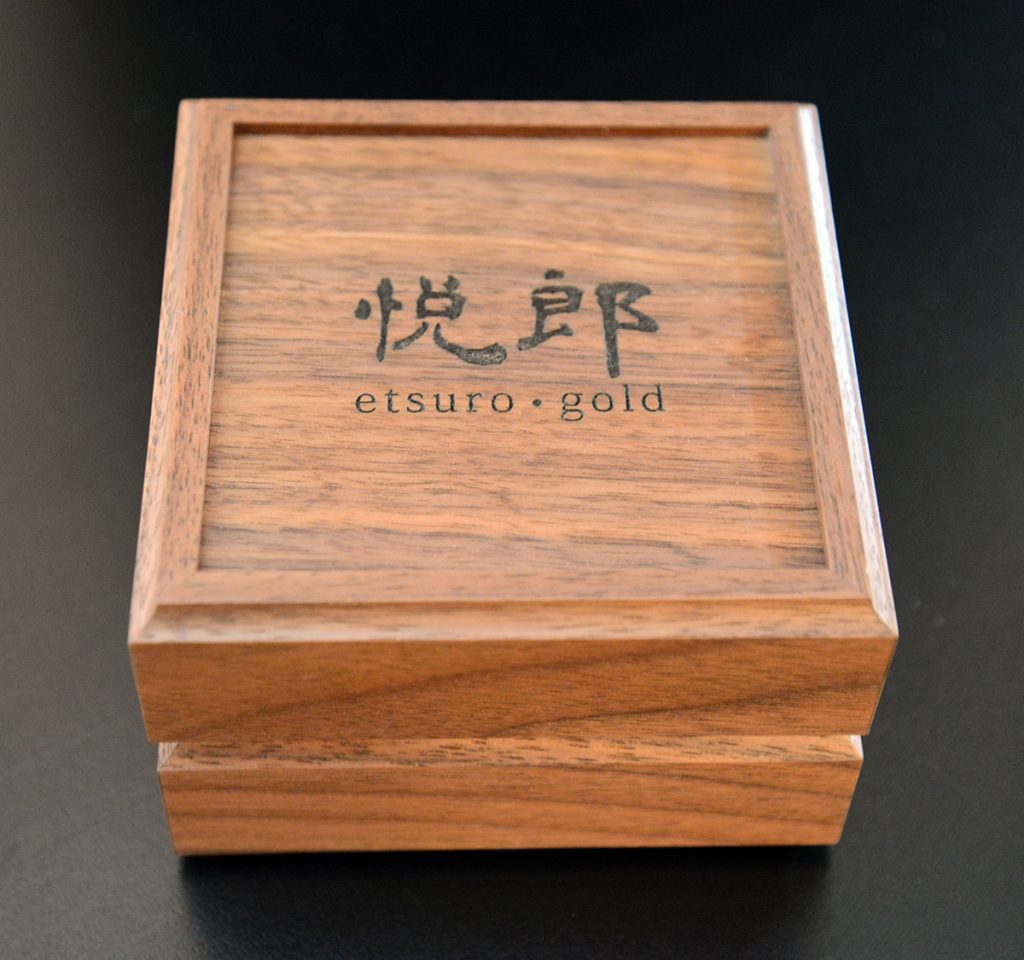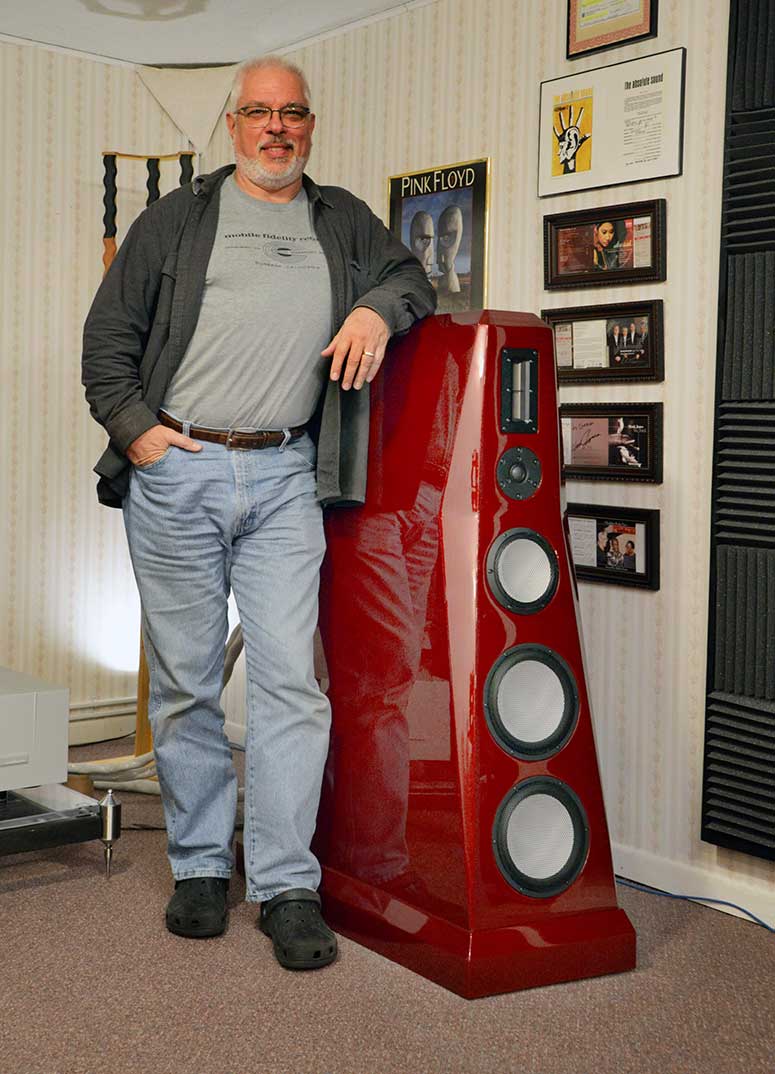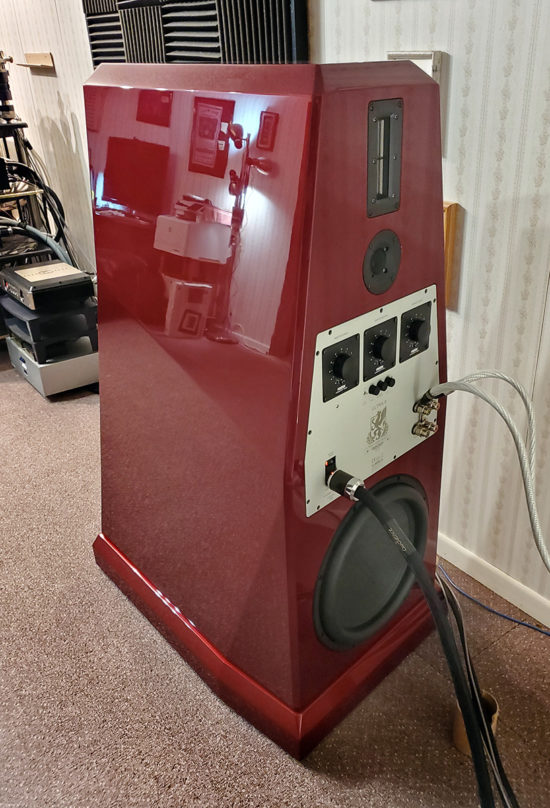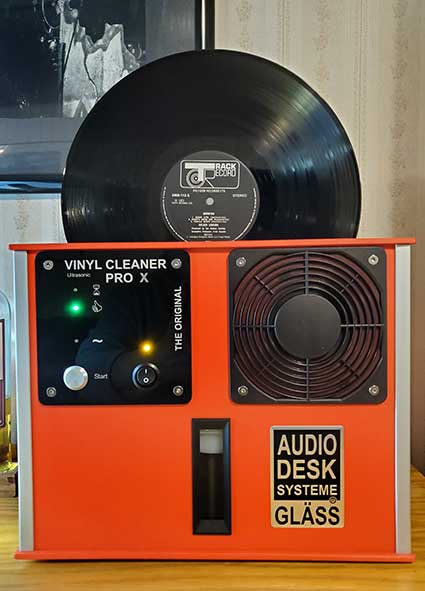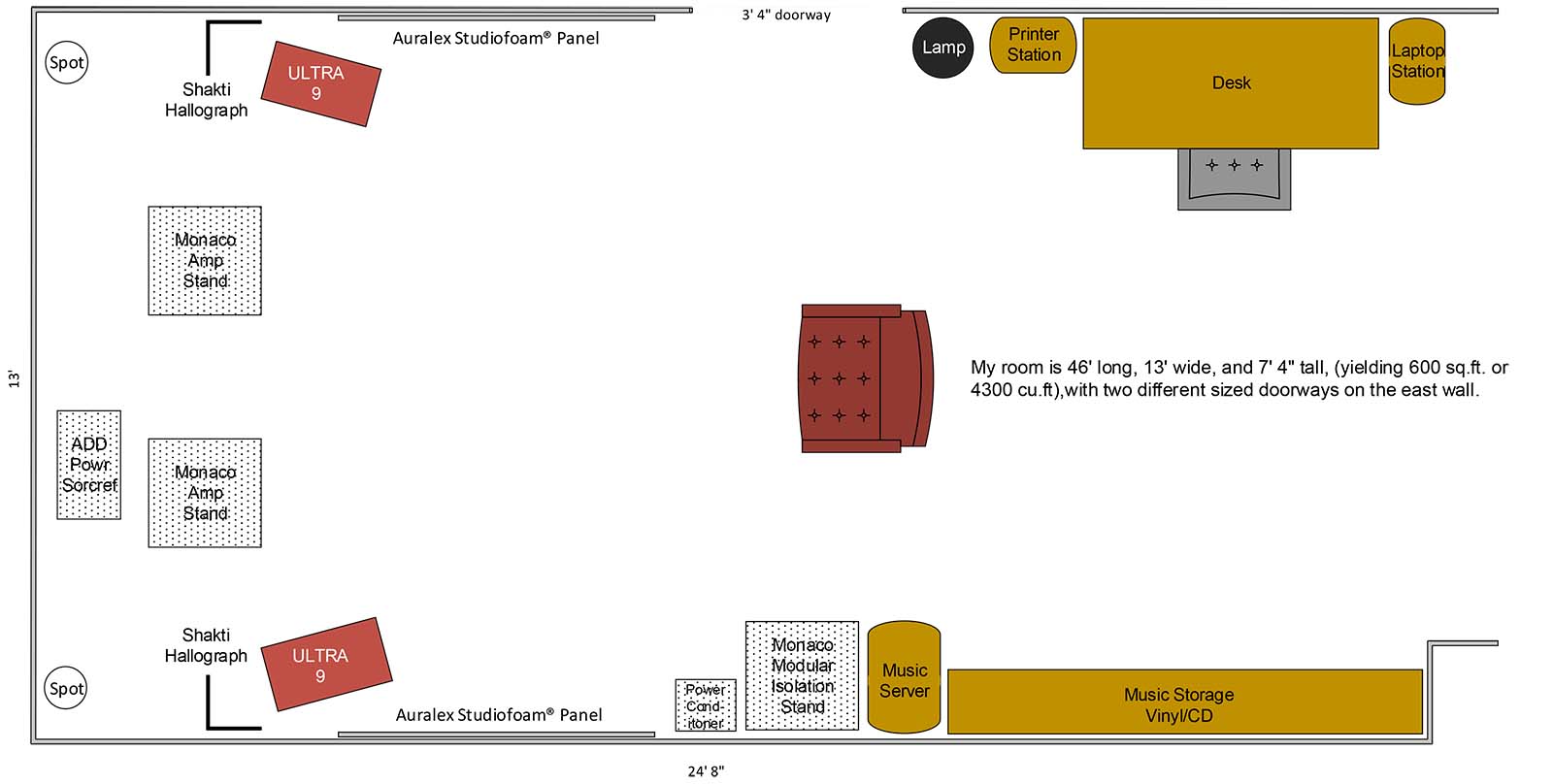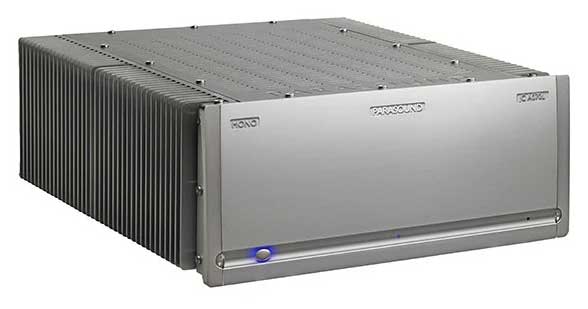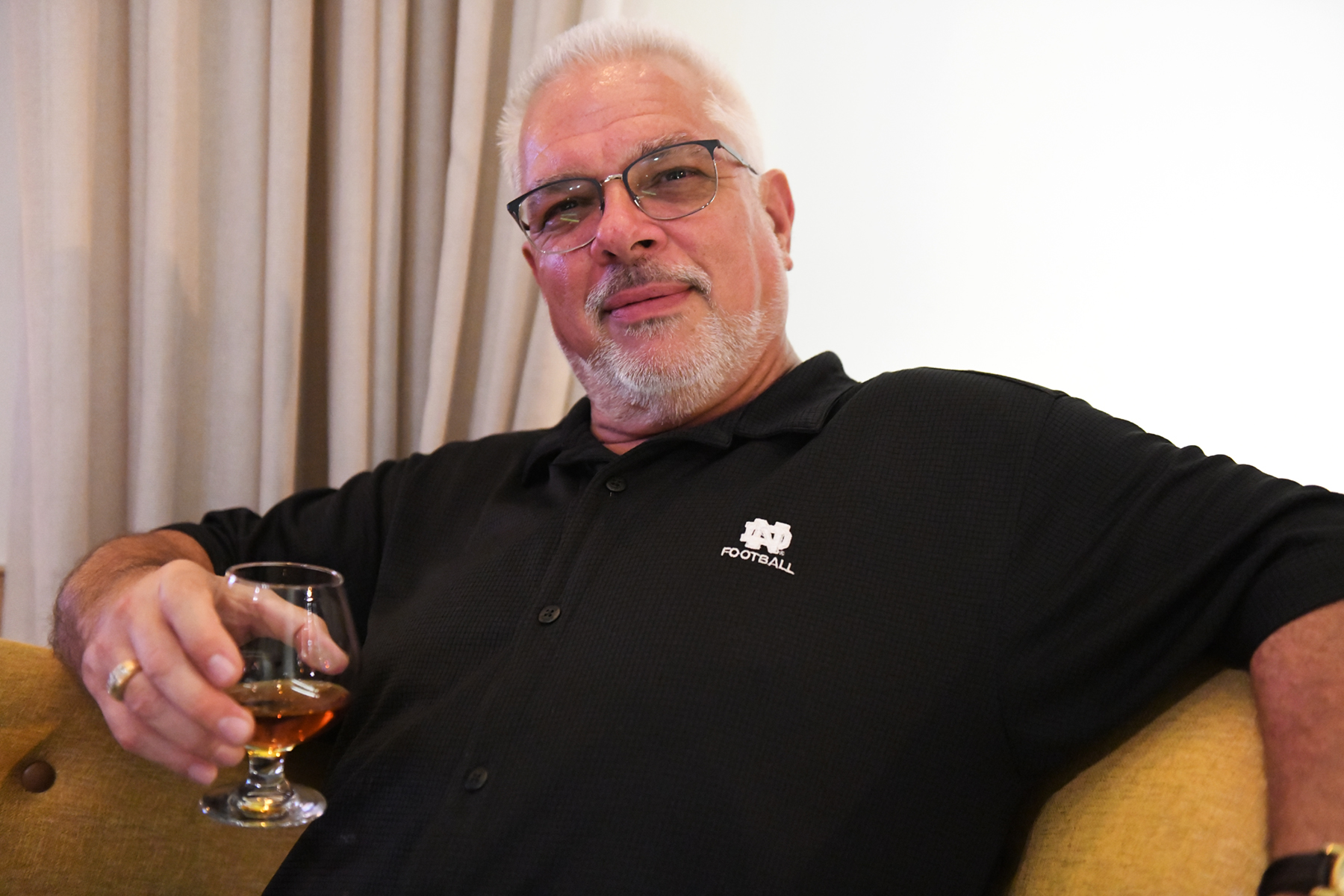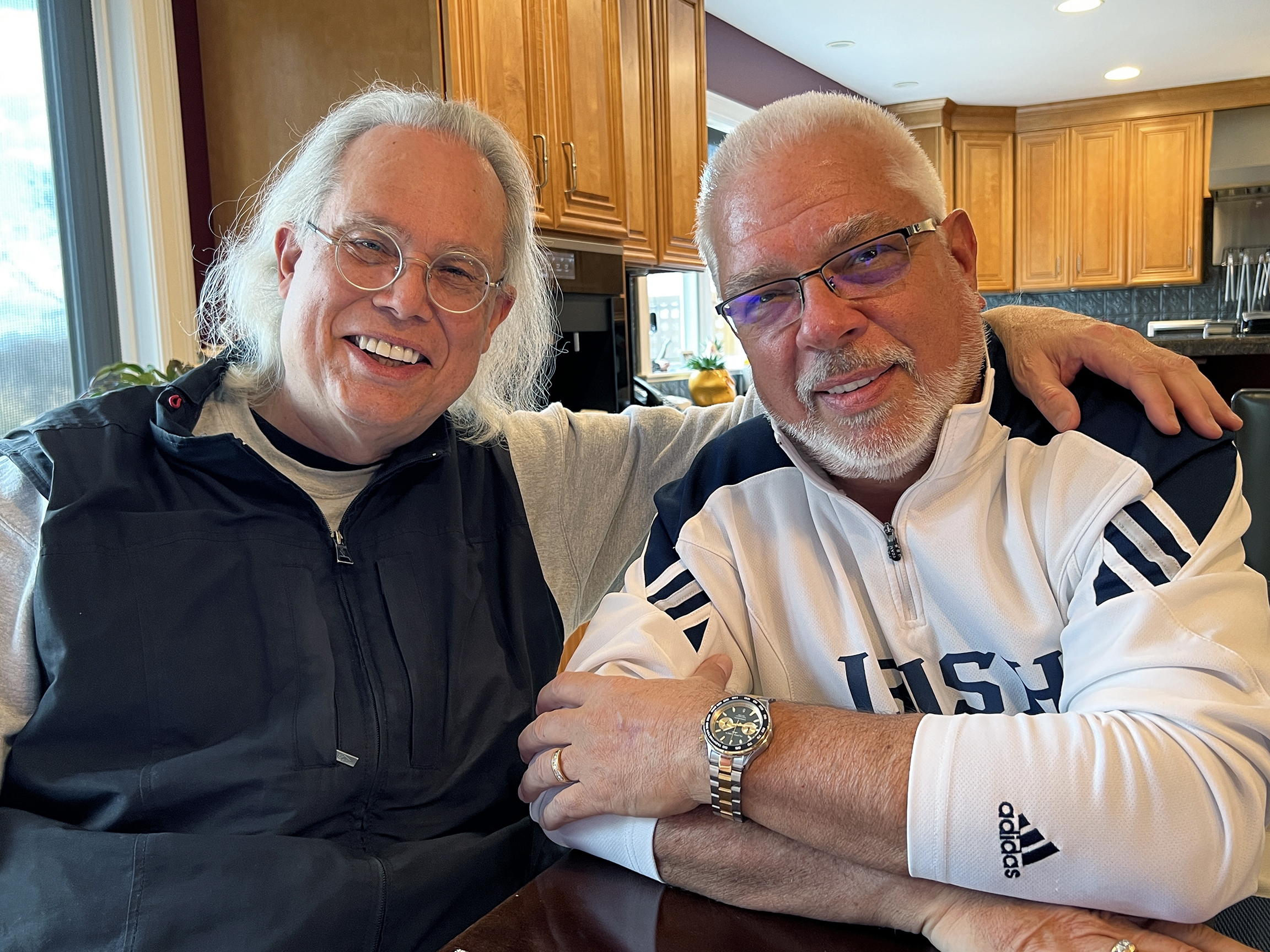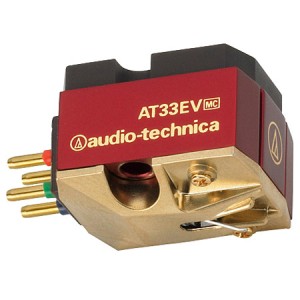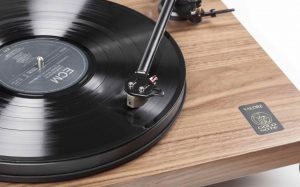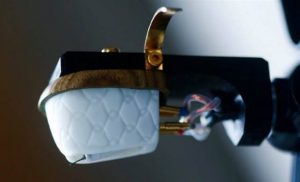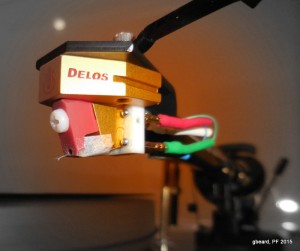The New Etsuro Gold Moving Coil cartridge, riding on the Kronos Helena tonearm over the Kronos Sparta Turntable
I will admit to more than just a fleeting piquing of curiosity when Believe High Fidelity Owner Joshua Masongsong published a Facebook post just after the first of this year that the first Etsuro Gold MC cartridge, from Japan's esteemed Etsuro Urushi, had arrived in the US. My offhand reply to that post, merely a request that he "…keep us informed" as to what he heard, led to his offer to have me do this review just 10 days later. After some run-in time and client auditions, this magnificently appointed cartridge arrived for my musings just three weeks before AXPONA. I'll save those who like to scan ahead to the conclusion some trouble; this is a reference-level transducer and is one of the two or three most engaging and authentic sounding cartridges I've ever experienced.
Construction
The Etsuro series of MC cartridges currently consists of three models, the Cobalt Blue ($6,000), the Bordeaux ($8,500), and the new Gold ($21,000!). This lineup represents joint development between Mr. Masao Okada, CEO/CTO of Excel Sound Co., Ltd., established April 1, 1970, (with half a century's experience producing hand-built MC cartridges), and Mr. Etsuro Akiyama of Dai-Ichi Shoji Co., Ltd., which though founded December 12, 1952, has been exporting audio equipment (including phono cartridges and electronic measuring instruments) since the 1970's.
The two companies started manufacturing the Etsuro MC Cartridge series with the joint goal of representing time-honored Japanese handmade craftsmanship as well as attaining a level of quality and performance that had not been accomplished previously. It will then come as no surprise that these hand-crafted cartridges are low-volume production items, meticulously produced individually by skilled craftsmen using carefully selected materials. Just as China may lay claim to creating the finest porcelain, Japan is renowned for its superb quality lacquerware. Etsuro Urushi takes part of its name from the whitish rubber-like tree sap used in the traditional lacquering process, which can be pigmented and refined and used as a coating to harden, stiffen, or preserve any number of items.
Once the coating is applied and dried through various technical processes, its natural varnish-like finish offers superb adhesion and strength. The result of this treatment is distinctly rigid, and claims to afford more rigid, less resonant performance than can be achieved with the use of today's available chemical coatings. Urushi is also known for its resistance to alkalis, acids, alcohol, and water, to provide thermal insulation, as well as preventing or arresting the growth of microorganisms. Because urushi offers these superior strengths, as well as a distinctively beautiful shine, for centuries it has been the established treatment for traditional artworks and musical instruments, even for the body armor of the Samurai. But enough history…
Though I searched for and requested more detail on the motor assembly and construction, nothing highly specific could be found or was returned. However, given what I'm hearing with this delightful cartridge, it is clear that they have "subscribed" to the methods first pioneered and proven with the original Air Tight PC-1, circa 2006.
Until that time, there seemed to be an insurmountable trade off. You could have either rich tone or breathtaking transparency from an MC motor; getting the best of both in the same cartridge was elusive to say the least. While a high output MC cart using a high count of coil windings would yield vibrant energy and vivid timbre, the subsequent higher impedance from the amount of wire used relegated fine detail. And by contrast, fewer windings, which reduces impedance and output, offered improved resolve and greater transparency at the expense of tonal density and dynamics. For years, this was the MC conundrum.
It was at that time that Air Tight's founder, Atsushi Miura, who had headed Japan's Lux Audio until its sale to Alpine in 1984, worked in collaboration with Yoshio Matsudaira, the legendary master of moving-coil cartridge design. Mr. Matsudaira has designed and built many of the most revered cartridges for distinguished houses like Air Tight, Audio Craft, Haniwa, Koetsu, Miyabi, and Supex, among others.
Following his exhaustive research at MY Sonic Lab, Mr. Matsudaira discovered a way to solve the puzzle; he used an ultra-high permeability (in this case, the influence of a substance on the magnetic flux in the region it occupies) Ferrite magnetic core material. With the development of a magnetic material with roughly three times higher flux density than any of the existing high-µ materials available at that time, he could use fewer coil windings (reducing core-saturation loss and impedance) to produced higher output voltages. The Air Tight PC-1 was the first cartridge released using this higher flux density magnetic core formulation.
Such high-µ materials are readily available these days, and while research is ongoing, with everyone looking for that next mega-step up in permeability, they are commonly employed by top-flight cartridge manufacturers today. As such, what I can tell you is that the magnetic circuit of the Gold is a non-disclosed combination of electromagnetic soft iron and samarium cobalt, specifically selected to maximize the magnetic interactions with the coil vibration to ensure overall tonal balance and density.
Their hand assembled coil uses select components fabricated from specially treated pure copper and is wound in-house. Because of the individual attention imparted to each step of fabrication, the accuracy and consistency of windings, monitored by skilled craftsmen, it is said to yield a level of unmatched uniformity.
The Etsuro Gold uses a finely polished, 80μm MicroLine profile tip, a profile that many consider to be the ideal contact surface, particularly with the uppermost frequency range. It features a 0.22mm diamond cantilever. Diamond provides very high vibration transmittance speed with minimized superfluous resonance, all in service to increased resolution. In fact, such a diamond cantilever is offered in the brand new $10,500 Ortofon Anna Diamond MC cartridge, to elevate the performance over the stock Ortofon Anna.
The cartridge housing is fashioned from a super rigid aluminum-based metal alloy known as Duralumin A7057. Specifically, A7075 is an Aluminum alloy containing roughly 5.6 - 6.1% zinc, 2.1 - 2.5% magnesium, 1.2 - 1.6% copper, with less than a half percent of silicon, iron, manganese, titanium, chromium, and other metals. Originally developed in Germany in 1903, Duralumin offers excellent mechanical properties, including good ductility, high strength, resistance to fatigue, and has significantly better corrosion resistance than many other aluminum alloys. This makes it one of the go-to alloy's when the application calls for high stress structural applications. As such, it has been extensively utilized in the production of structural components for aircraft.
The surface of the cartridge housing is then finished with a traditional Japanese craft technique. In collaboration with one of Japan's most well-known metal leaf developers, Hakuichi Incorporated, located in Kanazawa prefecture, where 98% of all Japan's gold foil production takes place, "Hon Kinpaku," 24K purity traditional gold foil, is applied to the rigid Duralumin body. While said to further reduce unwanted resonance, it is the application of this elegant gold leaf (roughly 0.0001 - 0.0002 mm thick!) by craftsmen in traditional fashion that confers upon the Gold its germane name, at the same time establishing a link with artesian Japanese culture that has been passed down for hundreds of years.
Finally, that remarkable housing is affixed to a 2.5mm pure sapphire base, for firm support and mounting to your chosen tonearm head shell, while the body terminal pins also include 24K gold plating.
Coherence
The associated equipment used for this evaluation included my Kronos Sparta turntable ($24,000) using the Sparta Super Capacitor Power Supply ($9500), fitted with their Helena Tonearm ($7850), where the Etsuro Gold replaced my long-time reference Air Tight PC-1 ($8500). (Oh, so that's why he went into such detail about the PC-1!)
Amplification was provided by the new Valve Amplification Company flagship Statement 450i iQ integrated amplifier ($150,000), using its native Statement MC phono stage, and loudspeakers were the new Von Schweikert Audio ULTRA 9s ($225,000/pr.). I also used the VSA VR-55-Aktive loudspeakers ($60,000/pr.), the Constellation Inspiration series Linestage ($9900) and Stereo Amplifiers ($11,000 each, two used in vertical biamp configuration), or the DSA Pre I ($16,500), and AMP I monoblocks ($24,000/pr.), with either the DSA Phono II ($13,500) or the ModWright Instruments PH-150 Reference ($7900).
Interconnects and speaker cables were the Stealth Śakra V12 ($19,600/pr.) and the Dream V14 ($18,600/pr.) respectively, as well as the Helios phono cable ($10,800). AC cords were all Audience frontRow series ($6000 to $7000 based on power rating and length), and power conditioning was handled by the Audience adeptResponse 12 ($14,000 with frontRow power cable) and PS Audio DirectStream P20 Regenerator ($10,000). All gear rested on Grand Prix Audio Monaco series stands ($16,500), with Critical Mass Systems CenterStage2 footers ($13,800 total) under all components, save for the VAC integrated.
From the very first serious needle drop after I had dialed in the alignment, it was clear that this was an exceptional cartridge. The first thing I noted was that individual voices, be they the artist, their backing vocalist/s, or the separate instruments in play for the session, had taken on as authentic a sense of individuality as I've heard from ANY vinyl playback system. With the Gold, each separate voice had the most holistic, well-formed, and stably placed location, size, and body I've yet heard recreated by an LP playback system! This speaks to its utter quietness (i.e., curtailed level of distortion) and consummate speed, yielding this superb level of reconstruction of detail.
Its extraordinary ability to reproduce bass was revelatory. From the lowest imaginable frequencies, like those that positively pressurize the entire listening room when the lowest key on the organ is depressed in the second movement of Saint-Saëns Symphony No. 3 (Mercury SR-90012), or from the Blade Runner 2049 - Original Motion Picture Soundtrack (Epic/ASG 88985494341), through the regeneration of musical drama like that served up by Jeff Porcaro's churning drum storm near the climax of a "It's a Miracle," from Roger Waters' masterpiece, Amused to Death, (CBS/Sony 468761 0), to conveying the vital skin tone and ominous portend of the tympani in the Fourth Movement of Beethoven's Symphony No. 9 In D Minor, by Solti and the CSO (MFSL 2-516), the Gold offers the fastest, most distinctly and individually pitch defined bottom end I've heard! All offered up with an authentic sense of body, timbral faithfulness, and unyielding yet utterly articulated weight, impact, attack, and transient fidelity, that are simply unsurpassed in my experience. Extraordinary!
Midrange with the Gold is staggeringly rich, yet not overemphasized, with a genuineness of timbre available from only a few of other carts I've heard. Listening to voices as chilling and powerfully expressive as David Bowie on the 12" UK 45 RPM single Cat People (Putting Out Fire), (MCA MCAT 770), the stirring vocals and unrelenting guitar on the title cut from Stevie Ray Vaughn's Texas Flood, (Mobile Fidelity UD1S 2-005), or the sounds of the Bösendorfer Imperial piano as marshalled to life by Ikuyo Kamiya on the Beethoven Piano Sonata No. 23 in F Minor, Op. 57 "Appassionata," (RCA - RDC-4), repeatedly showed this remarkable cartridge to be at the fore in creating vital, honest tone color.
I was also struck by both its inspiring neutrality of timbre and sense of effortless extension in the uppermost frequencies. With speakers that have the ability to render what this cartridge can recreate, you will be treated to benchmark smoothness and effortlessness with a wholistic and complete sense of tone color and texture.
As well as exhibiting such diminishingly low distortion, exceptional resolution, and speed, its lack of distortion and resultant unrivaled clarity give it a phenomenal ability to recreate soundstage cues and image sizes and locations. Lesser MC designs can compress instrumental size with decreasing frequency runs, offering a sense that their projected voice, in volume, power, and to some degree, timbral faithfulness, diminish as well. This affects the overall sense of tonal balance and changes the way the instruments populate the soundstage. It is a very unsettling effect, one I'm happy to say that the Gold seems remarkably impervious to.
But it's ability to unravel even the most complex orchestral or rock compositions and to portray those dense, intertwined, and compound compositions as a series of unique, individual voices, rather than just a congealed mass, is superior to any other cartridge in my purview. Further, the power of this incomparable ability to depict such remarkable granular distinctiveness, representing individual contributions more clearly, only serves to make those contributions more cogent to the "whole" tapestry of the recording, imbuing it with a distinctive ability to present an amazingly authentic reality of the entire sonic landscape. It clearly expresses the sensuality, the feeling, the sensitivity, and the passion, of everything it traces.
Completion
In précis, with the Etsuro Gold, details are clearer, bass is better extended, much faster, and far more detailed, timbres are truer, air is more plentiful, dynamics are more lifelike, and stage width, depth, and height are expanded to surprisingly realistic dimension. I'm hearing detail, color, microdynamic fluency, dynamic contrasts, layering, dimensionality, and an individuality to voices, human and instrument, that can only be approached, if not equally matched, by a handful of other exquisite MCs today. The closest contenders I've heard would be the $15,000 the Air Tight Opus 1 or the $16,000 ClearAudio Goldfinger Statement.
So, as pricey as this cartridge is, I am putting my money where my mouth is, as the old idiom goes. At Munich High-End, Joshua and I had a discussion, and I'm sending my check. The Gold is my new reference. I simply do not know how I could offer a higher recommendation.
Gold Moving Coil Cartridge
Price: $20,999
Etsuro - Urushi
Yokohama, Japan
US Importer: Believe High Fidelity
Specifications
- Type: Moving coil
- Frequency response: 10-50,000Hz
- Output voltage: 0.3mV/1kHz
- Output balance: <0.3dB/1kHz
- Channel separation: 33dB/1kHz
- Tracking weight: 2gr
- Impedance: 4Ω/1kHz
- Trackability: >70μm/2gr
- Stylus shape: 80μm microline diamond
- Cantilever: 0.22mm Diamond
- Cartridge base: 2.5mm pure sapphire plate
- Cartridge housing: Extra super duralumin(A7075)
- Housing processing: 24K Gold leaf "Kinpaku" finish
- Terminal pin: 24K Gold plated
- Cartridge weight: 8.7 grams
- Box Material: Walnut
All images by Greg Weaver




